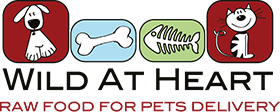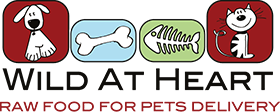Biologically Appropriate

The philosophy behind the biologically appropriate diet is that this is what their body was designed to eat. Although cats and dogs have been domesticated for thousands of years, their internal digestive system and physiology have remained virtually unchanged. A few thousand years is but a blink of an eye compared to millions of years of evolution. The biologically appropriate diet looks at what the diet of the wild ancestors of our pets was, and tries to mimic it.
Carnivores & Omnivores
Over the last decade the dog has been re-classified as a wolf. Despite changes in their physical appearance and behaviour, the physiology and mainly the digestive system have not changed. The dog is defined as a carnivore that behaves as an omnivore (or an omnivore that behaves like carnivore), a hunter and a scavenger. In nature the dog would eat anything from prey to insects, fruit and berries. The cat is a true carnivore and relies on hunting for its diet. Both species will eat the carcases of their prey whole and raw. Therefore their meals will naturally include internal organs, plenty of bones and vegetables including herbs, from the gut of their prey. Other then the intestine content of other animals they will eat no grains. Both species rely on meaty bones as a major part of their diet.
The Common Alternative
Most people feed their pets dry (kibble) or canned food. Most vets would recommend the same food, with maybe a preference to one brand or another. In the last 60-70 years, processed pet food has become the standard and the companies who make them have become the main authority on what is the best nutrition for your pet. Without trying to 'demonize' those companies, these facts raise a few questions:
- What did pets eat in the thousands of years they were human companions and in millions of years before that?
- Is there no conflict in interest when a business that sells food teaches vets about nutrition?
- What do they put in those crunchy kibbles?
- If it's so healthy, why are pets so sick?

During the existence of both dogs and cats they relied mostly on prey. Dogs would also resort to scavenge whatever it could find. Since they were domesticated they would probably receive the bones, meat leftovers and any other scrap left by the owners. In rural areas (which used to be the majority) there were always farm animals being slaughtered with plenty of meaty bones left for them. The digestive system of your carnivore pet is still tuned to eat the same way. 70 years is an insignificant time when it comes to evolution and biological adaptation.
Vets learn how to cure illness and 'repair' pets. They do not specialize in nutrition and are usually given very little training on the subject. That training, by the way, is given by the experts from the pet food industry. So what DO they put in commercial pet food? Many brands have 40-60% of carbohydrates as wheat or corn. There may be nothing bad with that for humans, but a dog or cat does not need nor is built to digest large quantities of carbohydrates. The stomach of the dog is short and acidic. It deals well with large quantities of protein which digests within a few hours. Carbohydrates on the other hand, may stay in the stomach for up to 12 hours, and may even start fermenting.
'Meat meal' - The meaty part of the commercial food. This is usually meat that is not fit for human consumption, and in many cases 4D (which stand for Dead, Diseased, Dying and Disabled). If that isn't bad enough, there are also reports of road-kill, pets that were put down in shelters, and restaurant grease. This is all done legally. Preservatives, stabilizers are added and then also vitamins and minerals. Considering that all the meaty and grain ingredients are thoroughly cooked there are a lot of enzymes, vitamins and nutrients that don't 'make it' by the end of the process. That is why they are artificially added later. One thing that strikes me as odd is the low cost and long shelf life of such food. The only thing I can think of that compares to it is the foods we call 'junk food'. We all eat them, but would you feed your family that type of food exclusively in every meal and every day? For a more indepth look at commercial pet food please check the Dog Food Advisor website.
The Benefits
Pet owners who made the switch to a raw diet have reported the following:
- The teeth become whiter and stronger
- The skin and coat become healthier and shiny
- Bad breath and odor are minimized or disappear
- Allergies disappear
- Better metabolism - weight lost or gained
- An overall stronger immune system
- Stool will be less in quantity and odor
The Cost
A healthier pet is probably priceless, and in the long run you will also feel the relief in the veterinary bills. Statistics show that pet owners end up spending more on their companion's (bad) health then the food they feed them. We look at raw feeding as preventative medicine and not just a way to satisfy your pets' hunger. On a daily basis a raw diet can be slightly more costly than 'high end' kibble or canned food, but there are many ways to reduce the cost, without sacrificing the quality.

